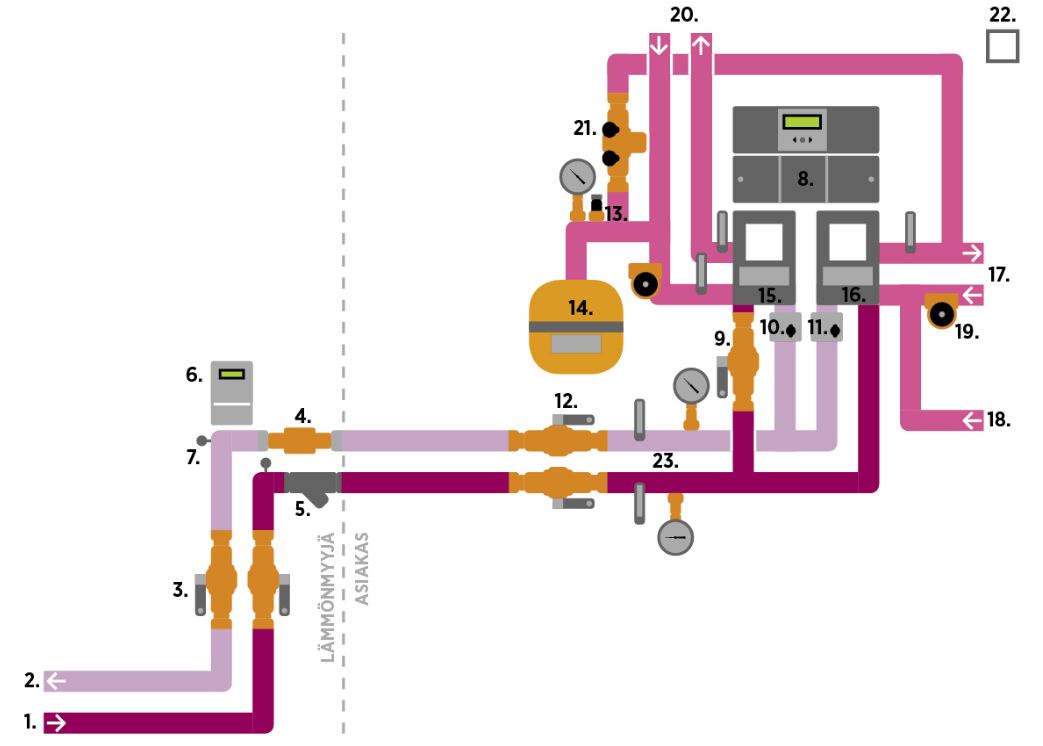
District heating equipment and maintenance
District heating customers are supplied with heat using hot water circulating in Helen’s district heating network. The customer’s district heating system distributes this heat to the property. On this page, you can find an illustration of the parts of the district heating system as well as instructions for adjusting the district heating systems and using them in an energy-efficient way.
District heating equipment at the customer’s property
The equipment in the heat distribution centre is usually durable and does not require special maintenance. The operation of the property’s control devices and heating should be monitored regularly by checking the supply and return water temperatures of the heating network at different outdoor temperatures. By ensuring the correct adjustments and condition of the heat distribution equipment, you can reduce your property’s energy consumption and also affect your heating bill.
The district heating equipment in the property is divided into equipment owned by the heat seller and equipment owned by the customer.
Frequently asked questions about district heating equipment and maintenance

Helen is responsible for the following at the customer’s property:
1. District heating supply line
2. District heating return line
3. Heat seller's main shut-off valves
4. Flow sensor
5. Dirt trap
6. Heat volume counter
7. District heating temperature sensors
Temperature sensors, heat volume counter and flow sensor form a metering centre that meters the amount of water circulating through the customer’s district heating equipment and calculates the amount of district heating energy consumed by the property.
The purpose of the dirt trap is to filter out any pollutants from district heating water and prevent them from entering the customer’s district heating system.
The customer’s district heating equipment includes:
8. Control point
9. Summer shut-off
10. Heater control valve
11. Hot water control valve
12. Customer main shut-off valves
13. Safety valve
14. Expansion vessel
15. Heat exchanger for heating
16. Hot water heat exchanger
17. Hot water
18. Cold water
19. Pump
20. Heating network
21. Filling valve
22. Outdoor air temperature sensor
23. Pressure and temperature gauges
The heat exchanger is a central part of the system. District heating water transfers heat in the heat exchanger to the property’s heating network and hot water as well as to the ventilation heating circuit.
Primary and secondary circuits
The district heating equipment in the customer’s property is divided into primary and secondary circuits. The primary circuit is comprised of pipelines and devices through which district heating water flows or which are affected by the pressure of the district heating network. The secondary circuit, on the other hand, is comprised of pipelines and equipment in which the water heated in the customer’s heat exchangers flows or are affected by its pressure.
Further information
Reduction in temperature refers to the temperature difference between the supply and return water of district heating. The water flowing through the customer’s district heat exchanger is cooled down in the exchanger when it transfers the heat to the water in the property’s network.
In summer, a good reduction in temperature is between 15°C and 30°C. In summer, heat is only needed to heat hot water and the temperature difference is the smallest.
In winter freezing temperatures, the reduction in temperature can be between 50°C and 70°C, temporarily up to 80°C depending on the building’s technical systems.
A very high district heating return water temperature, i.e. low reduction in temperature, indicates that the control valves in the primary circuit are not working as desired. In this case, the district heating water flows through the heat exchangers unnecessarily hot, causing unnecessary energy waste and a potential risk of accidents due to overheated hot water.
If necessary, you can get help with the adjustment and maintenance of customer equipment from a control equipment maintenance company or a district heating contractor approved by Helen; they will inspect and repair the faulty equipment.
The temperature of district heating supply water varies between 65 and 115 degrees depending on the outdoor air temperature. The colder the outdoor air temperature, the hotter the district heating water.
If you notice that the temperature of the district heating water entering your property is not as shown in the graph, this may be due to a district heating construction site in your area. Check if there is a planned outage in your area. If there is no planned outage, contact our technical support to investigate the matter.
Finnish Energy has updated its guideline “District heating of buildings, regulations and instructions” (Publication K1/2021). According to the guideline, the temperature of district heating supply water will be reduced from 115°C to 90°C. This will create an even more energy efficient district heating system in the future and drive the transition towards carbon neutrality.
The electricity consumption of the pumps in a district heating system varies considerably depending on the type of building, the pump control method and the pump capacity. Below are indicative estimates of the electricity consumption of pumps in different types of buildings as kilowatt-hours per year:
Detached house category
- Electricity consumption for detached house category pumps: 170–500 kWh/a.
Terraced house category (5–15 apartments) - Total electricity consumption of terraced house pumps: 250–700 kWh/a.
Apartment building category (30–60 apartments)
- Apartment building with 1 heating circuit: 300–1,100 kWh/a.
- Apartment building P+IV: 400–1400 kWh/a.
Apartment building category (80–100 apartments)
- With a radiator circuit: 650–3,100 kWh/a.
- P+IV: 900–4,200 kWh/a.
In larger residential and commercial buildings, the control method of the pump can also have a significant impact on electricity consumption. Some of the most common ways to control pumps include:
- Standard curve
- Relative pressure
- Constant pressure
- Constant flow
- Constant temperature
For more information about pumps and different control methods, please contact, for example, your HVAC engineer or equipment supplier.
1. Monthly Heating Home (less than 50 MWh/a)
You can influence the usage power by reducing consumption by, for example, taking care of the condition of the heat distribution equipment, the correct settings of control curves and through heating consumption habits. District heating energy is used to heat the premises andhot water.
Condition of heat distribution equipment: Make sure that the heat distribution equipment is in good condition and working properly. Regular maintenance and inspections help to keep your equipment working efficiently. If necessary, HVAC professionals can assist with inspection, maintenance and modification of the equipment.
The replacement interval for the equipment is usually approximately 20–25 years. The year of installation can be found in the connection diagram
Control curve settings: Check and adjust the heating system’s control curve settings. Correct settings ensure that the heating system works optimally and consumes less energy
Consumption habits: Pay attention to heat consumption habits. For example, lowering the room temperature by one degree reduces heating energy consumption by approximately 5%. Reducing the consumption of hot water can also significantly reduce energy consumption.
The operating efficiency and basic fee pricing for detached houses can be found here.
You can monitor your property’s district heating consumption data in Oma Helen. In addition to consumption, the page also contains information on your property’s current usage power and basic fee.
2. Monthly Heating Property
You can influence your usage power by saving heating energy through consumption habits and by maintaining the condition of the heat distribution equipment and the correct control curve settings of the equipment.
District heating energy is used to heat the premises and hot water and for ventilation.
With regard to the consumption of district heating, it is worth paying attention to energy savings and the timing of consumption so as to avoid high consumption peaks. District heating consumption peaks refer to days when the use of district heating is higher than average.
You can influence usage power during the heating season through your own actions, and the greatest benefit can be achieved during heating peaks. The most important actions that the resident can take to influence their own usage power are:
Consumption habits: Pay attention to heat consumption habits. For example, lowering the room temperature by one degree can significantly reduce heating energy consumption.
Avoiding peak consumption: Aim to schedule heat consumption evenly and avoid high consumption peaks. For example, the highest consumption of hot water should be scheduled outside peaks of freezing temperatures.
Checks and adjustments before the heating season can improve the performance of the equipment and reduce the required usage power. If necessary, the measures below can be implemented in cooperation with property maintenance or the HVAC engineer/contractor.
Condition of heat distribution equipment: Make sure that the heat distribution equipment is in good condition and working properly. Regular maintenance and inspections help to keep your equipment working efficiently. The replacement interval for the equipment is usually approximately 20–25 years. The year of installation can be found in the connection diagram.
Control curve settings: Check and adjust the heating system’s control curve settings. Correct settings ensure that the heating system works optimally and consumes less energy.
Adjusting the radiator network: Checking the operation of the radiator network before the start of the heating season is recommended. By making the necessary adjustments and by balancing and bleeding the network, it may be possible to lower the temperature of supply water in cold weather.
Other heating networks: In properties with ventilation or an underfloor heating network, it is also a good idea to ensure their functioning before the heating season. In these systems, air trapped in the network, for example, can also have a significant impact on heating performance. Balancing and bleeding the network is important to get the biggest benefits.
Usage power and basic fee pricing for housing companies can be found through this link.
You can monitor your property’s district heating consumption data in Yritys Helen. In addition to the consumption, the page also contains information on your property’s current usage power and basic fee.
In newer district heating systems, the automation takes care of shutting off radiator and other heating networks during the summer by controlling the control valves based on the average temperature. We recommend running the circulation pumps of the heating circuits for a “refresh” approximately once a week. The pump can be set to start automatically for 10 to 15 minutes, for example, to prevent the pump from getting dirty, clogged or rusty. It is best to let the system take care of these tasks.
If automation is not available in apartment buildings and commercial premises, the control of the summer shut-off valves is primarily taken care of by the property maintenance company. In detached or terraced houses, the use of the summer shut-off is the responsibility of the property owner. If you want to make sure that no district heating water is used for heating during the summer, shut off the summer shut-off for the summer months. Shutting off the summer shut-off does not affect hot water heating.
The above-mentioned “refresh use” of the circulation pump is also the responsibility of the property owner. To prevent sediment build-up and pump clogging, it is advisable to start the pump briefly a few times during the summer. In addition, it is a good idea to briefly turn the radiator thermostats open from time to time.
It is important to remember that the hot water settings must not be changed. The temperature of the network water must be 55–58°C and hot water circulation must always function normally (in old properties, the return temperature of the hot water circulation can also be at least 50°C). This is to prevent the formation of legionella bacteria in the hot water network.
You can learn more about water consumption habits on Motiva’s website.
The water in the district heating network is dyed green so that pipe leaks and any equipment failures can be detected as quickly and easily as possible. If you notice a leak in the heat distribution centre, you must notify the property maintenance company or contact an HVAC contractor.
Green water may come out of the tap. This may indicate a leak in the hot water exchanger and the district heating water is mixing with the hot water network.
The water can be used for showering, but the use of hot water as domestic water should be avoided. Cold water can be drunk normally from the tap after letting it flow for a while. Please remember that only cold tap water should be used as domestic and drinking water.
Greenish warm domestic water should not be used for cooking. You can still shower normally. You can also use the dishwasher and washing machine normally, as they usually heat their own hot water.
Contact your property’s maintenance company or HVAC contractor to have the exchanger replaced.
District heating equipment is usually replaced every 20–25 years
The average service life of district heating equipment is approximately 20–25 years. We recommend the replacement of old heat exchangers and other related heat distribution room equipment to ensure efficient operation.
As a district heating customer, we will provide you with free advice and help in all questions related to the heating of your housing company. We want to ensure the easy, affordable and comfortable use of district heating in your housing company. We monitor the energy consumption of all of our customers by using the metering data collected by remote reading. Our goal is to ensure that our customers have a high-quality and safe heating system.
We will provide you with information and a price estimate for the replacement of your heat distribution centre. We also carry out device replacements as a turnkey service.





